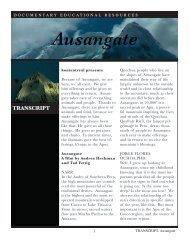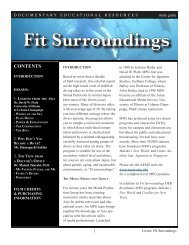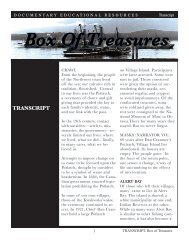Lessons from Gulam: Asian Music in Bradford - Documentary ...
Lessons from Gulam: Asian Music in Bradford - Documentary ...
Lessons from Gulam: Asian Music in Bradford - Documentary ...
Create successful ePaper yourself
Turn your PDF publications into a flip-book with our unique Google optimized e-Paper software.
D O C U M E N T A R Y E D U C A T I O N A L R E S O U R C E S study guide<br />
ernise the sound of Saz aur Awaz. He had obta<strong>in</strong>ed<br />
an electronic keyboard and some amplification<br />
and was now await<strong>in</strong>g the delivery of<br />
a conga drum set. He wanted to tra<strong>in</strong> Shaukat<br />
as lead s<strong>in</strong>ger of the group and for him to perform<br />
popular film songs. They also planned to<br />
write new songs together. However, as I got to<br />
know them better I realised that they were too<br />
committed to older and more traditional styles<br />
of <strong>Asian</strong> music for them to be able to succeed<br />
<strong>in</strong> these ambitions. Shaukat himself expressed<br />
doubts that he would ever have the confidence<br />
to dance about on stage. Naya Saz, a large<br />
group of younger musicians <strong>in</strong> <strong>Bradford</strong>, was<br />
already established as an <strong>Asian</strong> pop band,<br />
play<strong>in</strong>g ma<strong>in</strong>ly “hits” <strong>from</strong> the large corpus of<br />
Indian film songs. I could not imag<strong>in</strong>e Saz aur<br />
Awaz com<strong>in</strong>g up with the same k<strong>in</strong>d of stage<br />
show.<br />
Besides lead<strong>in</strong>g his qawwali group, <strong>Gulam</strong> was<br />
also leader of the workshop team recruited by<br />
Oriental Arts to give <strong>Asian</strong> music workshops<br />
<strong>in</strong> <strong>Bradford</strong> schools. Champak Kumar, Coord<strong>in</strong>ator<br />
of Oriental Arts, often took part <strong>in</strong><br />
the workshops, but was sometimes otherwise<br />
engaged and would then send Shaukat <strong>in</strong> his<br />
place. A third member of the workshop team<br />
was Norman, a Londoner who had lived <strong>in</strong> the<br />
<strong>Bradford</strong> area for many years. In 1986 he was<br />
mak<strong>in</strong>g his liv<strong>in</strong>g as a private music teacher,<br />
ma<strong>in</strong>ly of guitar (classical, jazz and folk). He<br />
had tra<strong>in</strong>ed as a school teacher but never felt<br />
able to submit to the f<strong>in</strong>al teach<strong>in</strong>g assessment<br />
and so had not qualified. He started play<strong>in</strong>g<br />
the sitar <strong>in</strong> about 1984 and was essentially selftaught,<br />
as a close exam<strong>in</strong>ation of his performance<br />
technique <strong>in</strong> the film reveals*. He had<br />
learned most of what he knew about rags, tals,<br />
and compositions <strong>from</strong> <strong>Gulam</strong>. Because he was<br />
the only musician <strong>in</strong> <strong>Bradford</strong> who played the<br />
sitar, Norman soon found himself <strong>in</strong> demand.<br />
This was a source of some embarrassment<br />
because he realiscd that he did not know very<br />
GUIDE: <strong>Lessons</strong> <strong>from</strong> <strong>Gulam</strong> 6<br />
much about <strong>Asian</strong> music. But the sheer sound<br />
of the sitar was enough for him to be courted<br />
by several groups, <strong>in</strong>clud<strong>in</strong>g Saz aur Awaz and<br />
Naya Saz. He occasionally played at <strong>Asian</strong> restaurants<br />
with <strong>Gulam</strong> accompany<strong>in</strong>g on tabla.<br />
In the workshops Norman did most, if not<br />
all, of the talk<strong>in</strong>g. This annoys some viewers,<br />
who see this as an example of the English<br />
participant occupy<strong>in</strong>g the position of power.<br />
Why should the white man, who has obviously<br />
learned about this music only recently, do the<br />
talk<strong>in</strong>g, while those best qualified to speak (like<br />
<strong>Gulam</strong>) are silent? <strong>Gulam</strong>, however, did not<br />
see it that way. As far as he was concerned,<br />
giv<strong>in</strong>g workshops was a chore and repeat<strong>in</strong>g<br />
the same remarks at four workshops a day, two<br />
days a week, a bore. He was quite content for<br />
Norman to be given the hard work. Norman<br />
could also expla<strong>in</strong> aspects of <strong>Asian</strong> music <strong>in</strong><br />
Western musical terms that school teachers <strong>in</strong><br />
<strong>Bradford</strong> familiar with that system could readily<br />
comprehend, and the workshops were for<br />
the benefit of teachers as well as pupils.<br />
III. THE FILMMAKING PROCESS<br />
<strong>Lessons</strong> <strong>from</strong> <strong>Gulam</strong> would be described by<br />
Breitrose as a “reflexive observational film”.





